In a surf set you can summarize different parameters and save these with a name. Every surf set has a unique name. When you are surfing you can select between the different surf sets.
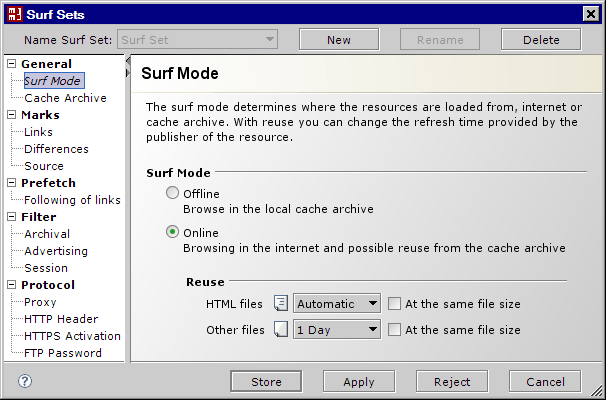
Control keys of the dialog have the following functions
| Button | Description |
|---|---|
| New | Create a new Surf Set. |
| Rename | Assignment of a new name. |
| Delete | Delete the displayed Surf Set. |
| Displays the corresponding description at the browser. Note: If the description isn't displayed, then you enter the browser in Options/General/Browser. | |
| Store | Stores revised Surf Set permanently. At the next start, the adjust settings are used again. The dialog is closed. |
| Apply | Apply revised Surf Set temporarily. |
| Reject | Changes are not taken. |
| Cancel | Changes are not taken. The dialog is closed. |
Surf Mode
The surf mode determines where the resources are loaded from internet or cache archive. With reuse you can change the refresh time provided by the publisher of the resource.
Offline
Pages are requested with their URL from the local cache archive in the offline mode.
Online
Online mode corresponds with normal browsing but available files in the cache archive can be re-used.
Re-use
At HTML files and other resources e.g. pictures the re-use can be adjusted in many ways. With re-use you can change the refresh time provided by the publisher of the resource.
- Never new request
Files available locally will never be requested again from the internet. - Time period: 1 minute, ..., 1 month
The locally available files are used in the adjusted time period.
The optimal setting depends on the application.
With a daily newspaper, time of expiry should not be set to more than one day, for example 12 hours. This has in general proved to be a favorable setting. - Automatic
Similar behavior like with corresponding settings in your browser. - Always new request
In this mode the respective files are always requested as new from the internet.
Furthermore you can define that a file is reused also at the same size.
Note: Not every server informs about the file size before the download.
Server was not available
A server isn't reachable and the called file locally available, so will be used with the local file. This corresponds to the setting never new for the re-use.
Cache Archive
Define folder
The whole WebAssistants cache consists of folders (specified by topics) where the resources of the internet can be saved. The cache archive can get arbitrarily large (except for restrictions of the operating system). It is necessary to use one cache archive at least.
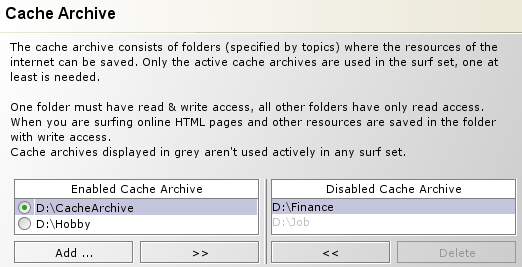
The left column lists the enabled cache archives of the displayed surf set. All other cache archives are listed in the right column. At this all entries written in grey aren't used in any surf set.
With the following buttons you can manage the archives:
| Button | Description |
|---|---|
| Add ... | Adds a further folder to enabled cache archives. |
| >> or << | Moves enabled to disabled cache archive or reversed. |
| Delete | Deletes a disabled cache archive displayed in grey. The folder and the contained resources aren't deleted in the file system. |
A folder must have read & write access in the column of enabled cache archives. All other folders have only read access. When you are surfing online the HTML pages and other resources are saved in the folder with write access. This folder is marked with a green point.
In the example above, four folders are given: The folder /CacheArchive/ and three folders specified by subject (Hobby, Finance, Job). By exchanging the entries you can compile any number of specific folders, which can also be stored on another storage device, like CD ROM.
If you assign several topic specific surf sets with only one directory, then you can select between these topics by browsing.
Moreover, the WebAssistant also can be started from a CD ROM. It is not necessary to install the program on a hard disk! Only a virtual machine must have been installed on the computer or in the network.
Note
-
You reach a higher flexibility by the separation from program folder and cache archive as well as use of several archives. The correct processing of very long URLs in addition requires, that at least 230 characters can be used for the path and the file name with the WebAssistant. Therefore use only folders for the cache archives which are located on partition level (Root), please. The maximum path name for this shouldn't be greater than 20 characters.
Very long URLs are often used for advertising. You also can be filter the advertising with Surf Set/Filter/Advertising.
- Delete of files with long path names
Archives don't correspond to the above for requirement perhaps with the Microsoft File Explorer deleting isn't possible. You then must use the DOS-Console to delete these files. You, for example, delete an archived domain with the following commands:
At first you change to the cache archives concerned, e.g. /CacheArchive/
cd \CacheArchive\
Then you delete the domain, e.q. example
rmdir example /s /q
with:
example- domain to be deleted
/s- Delete all included files and folders
/q- Without confirmation - One cache archive may not contain any other cache archives!
For example the following structure should be avoided:
1. Archive: /CacheArchive/
2. Archive: /CacheArchive/Hobby/
Marker
Efficient use of the archive by marking and highlighting words.
Links to archived resources mark
All links are marked green to available resources in the cache archive during surfing. So you get a fast summary of all resources, are already archived and thus locally available.

The marking can be used in the mode offline and in the mode online. The marking per default is green or can be defined with a stylesheet.
Offline Mode
Only the locally available resources can be shown in this mode.
Therefore the markings simplify surfing considerably.
Are you interested in the content of not available resources?
There are two possibilities for this:
- Change to the on-line mode.
- Collect the not available URLs at first
The collection is carried out via the fault message 404 File Not Found:- Manual about the link Add URL History
Any added URL is collected here. - Automatically about the protocol function Options/General/URL History/Surf Mode Offline/Any not found URL.
In this case every URL is collected.
- Manual about the link Add URL History
Online Mode
The marking shows to you, which resources you have already visited. This completes the history function of the browser.
Highlighting changes in the online mode
If you are interested in the differences in a page since the last archiving, then you activate this function. When surfing in the on-line mode newly available texts are then marked. The marking per default is blue or can be defined over a style sheet.
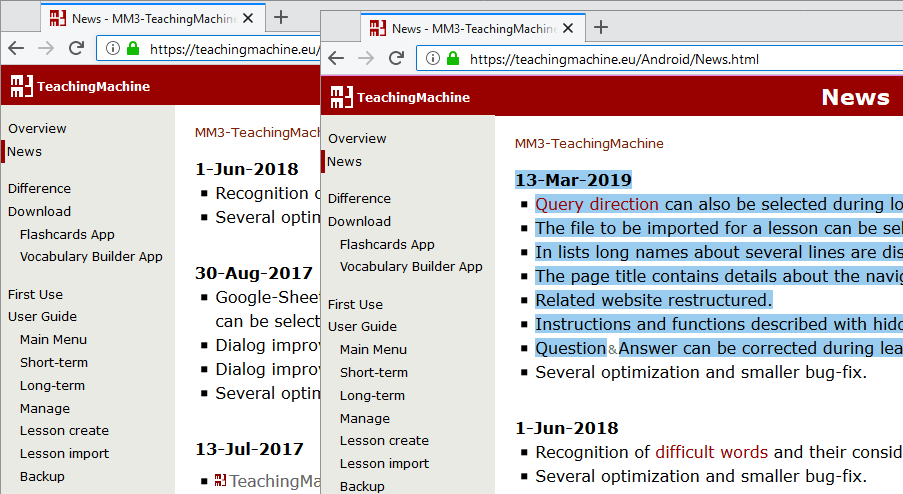
Mark sources in HTML pages
Resources are loaded locally into dependence of the settings from the cache archive or the internet. The source can be marked by a style sheet in the HTML tag of the page. The standard marking is made by a color line at the top of page. Four cases are distinguished:
| Marking | Source |
|---|---|
| Blue | From internet HTML page was added to the cache archiv |
| Violet | From internet HTML page was updated in the cache archive |
| Orange | From cache archive A newer HTML page wasn't available in the internet |
| Red | From cache archive |
Download HTML pages in advance
Starting from the HTML page currently visible, the prefetch traces additional links immediately and download the resource. These resources can always be used from the cache archive's continued browsing. However, this takes up a large proportion of bandwidth and memory space. Depending on application the depth of prefetch and the links to be traced can be specified as follows:
Links to be followed up in advance
Meaning of prefetch depth
| Depth | Meaning |
|---|---|
| 0 | Prefetch is deactivated. |
| 1 | Current page is loaded completely with all resources even after the page was already left. |
| 2 | All files referenced by links are loaded. A HTML page is loaded with all resources. |
| 3 | All files referenced by links as in depth 2 are loaded. A HTML page is loaded with all resources. All further depths corresponding. |
Within the structure
- In actual and deeper directory structure
- Only within the subdomain
- Within the domain
- All
HTML files and following types
- All
- Images
- PDF files
- ZIP files
Note
If you liked to archive a whole page (interlinked pages) automatically, you use the utility mirror.
Filter
Filter for Archival
These settings determine which and how resources will be archived.
Store resources
At activation of the option Store resources the files are stored in the directory with access to write.
In addition:
- All text files being compressed
- Download of a file is stopped
If you stop the download in the browser, the resource is not save.
The Prefetch must be deactivated (Depth 0).
Note
The parts which are not download are not available by offline surfing. - Archive selected Resources
You can decide with a filter which resources are saved or only displayed. Unlike the advertising filter all pages are, however, displayed completely in the browser furthermore. These filter settings can be combined in a set. You can work on such a set with an Set Editor and use in every Surf Set. The detailed structure of the filter is described: Filter for Archival
Note
It is securer not to use the WebAssistant in the field of confidential information.
Filter for Advertising
You hereby can prevent that e.g. advertising images will be loaded. For these not relevant resources result no cost for data transmission time and memory space. For automated filtering, restrictive operation has been chosen to make sure you are not denied content you may find interesting. According to our analysis it may make sense not to select the general browser setting, not to load images. We would rather advise to specify subdirectories and subdomains from which GIF images must not be loaded. If there are content of entire domains or subdomains you are not interested in, you can also specify these.
The WebAssistant can be used for many different purposes. It is difficult therefore to give any specific recommendations for filter settings. Possible applications may concern family filters or ad filters. For advertising purposes, GIF images are often loaded from specific subdirectories (e.g. advertising, adverts, ads) or other files from specific subdomains (e.g. ads). The filter setting prevents files to be loaded from the areas specified.
To configurate your application area, take note of the areas from which undesired files are loaded and specify these as a filter for advertising. You can combine these filters in a Set and edit the Set with an Set Editor. You then can use such a Set in every Surf Set. The detailed structure of the filter is described: Filter for Advertising
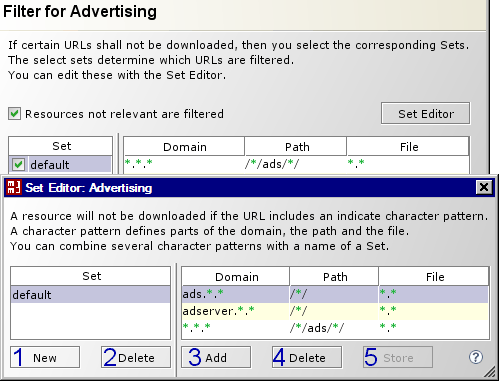
Control keys of the Set Editor have the following meaning
| Button | Description |
|---|---|
| 1 New | Create a new Set. |
| 2 Delete | Delete the selected Set. |
| 3 Add | Adds a character pattern to the Set. |
| 4 Delete | Delete the selected character pattern. |
| 5 Store | Save the selected Set with all character patterns. Character patterns with a red font are deleted because other patterns include these. |
Please note
Providing a large variety of options, the WebAssistant has not been conceived as an ads filter. It must also be noted that advertising is a considerable driving force for the development and maintenance of many products and does provide information. We have therefore refrained from a pre-configuration as an ad blocker. This is also why the program has no option to use image sizes for filtering. These same sizes are sometimes used to serve the offer. Filtering in this respect will therefore not contribute to a more efficient use of the internet.
Filter for Session
To identify users, some web sites use temporary identifiers in the URL. If an archive is used, these sites can therefore not be used to full extent. These sessions must be deleted for the use in an archive.
For the configuration you therefore take care which identifications are used at your visited web pages. Please specify these as Session Filters. You can work on such a set with an Set-Editor and use in every Surf Set. The detailed structure of the filter is described: Filter for Session.
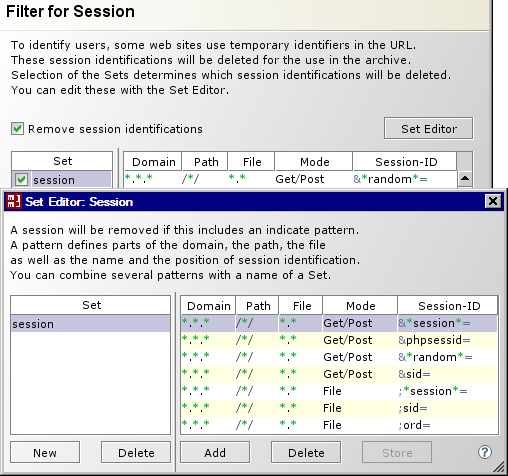
Protocol
The browser communicates with a web server via the protocol HTTP usually. The protocol HTTPS is used for a secure communication. Protocol FTP is used to download big files usually. Sometimes a proxy in addition is still used by your provider or in your local net.
Proxy
A proxy inserted behind the WebAssistant can be specified here for the protocols HTTP, HTTPS and FTP.
For the HTTP and HTTPS protocols, the data required for login (username, password) can be saved. This is implemented for the authorization methods "Basic" and "NTLM".
HTTP Protocol Header
The fastest data transmission is obtained with protocol HTTP 1.1. This is supported by the WebAssistant. The browser should also be configured with this option (see Browser Proxy Configuration).
The activation is specific of the browser:
- Microsoft Internet Explorer
Tools/Internet options/Extend/Parameters for HTTP 1.1 - Netscape (Mozilla)
Edit/Preferences/Advanced/HTTP connections - Opera
File/Preferences.../Network/Proxy servers
You can thus restrict the process of passing data on your browsing habits.
Reference
Standard setting causes the browser to transmits the present URL (reference) to the HTTP server by requesting another URL. This setting can be kept, or a reference can only be transmitted if it is in the same domain.
Browser name (User-Agent)
At standard setting, the browser will transmits its name to the HTTP server. This setting can be kept, or you can append an additional name.
Cookie
If the options is activated, cookies will be transmitted to the browser respectively to the server.
HTTPS Activation
Files encoded with the HTTPS protocol are stored as decoded files! If you do not activate this function, the data only are conducted by the WebAssistant. For complete deactivation switch off the HTTPS proxy in the browser (see Browser Proxy Configuration). We recommend this for transmission of confidential data.
Note
This function needs an internal port. You can change this port, see Options/General/Internal Port.
For the use of the protocol HTTPS an other configuration is necessary.
The implementation of the protocol consists only of a subset. Therefore some HTML pages cannot be displayed.
FTP Password for anonymous login
- Qualifier "MM3-WebAssistant@"
- E-mail address
- Individual qualifier